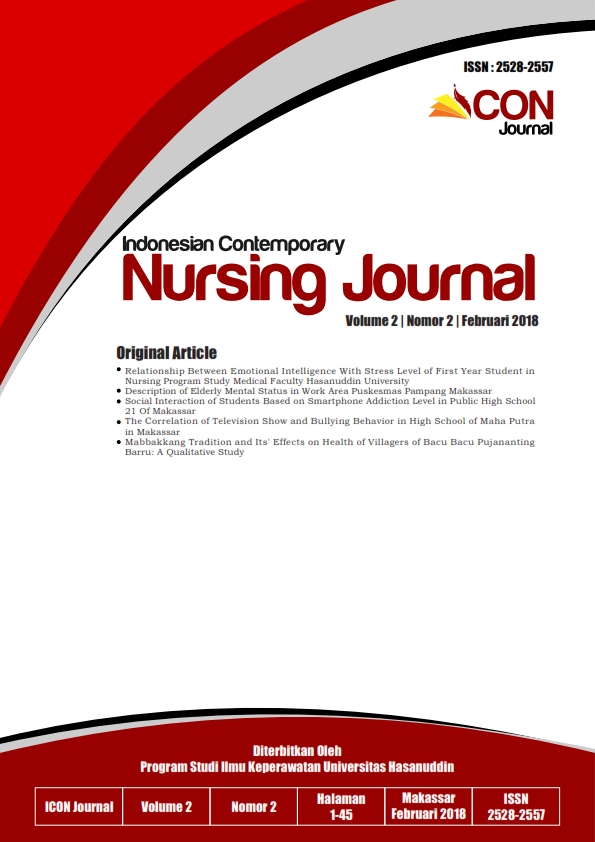Mabbakkang Tradition and Its’ Effects on Health of Villagers of Bacu Bacu Pujananting Barru: A Qualitative Study
DOI:
https://doi.org/10.20956/icon.v2i2.7689Abstract
Introduction: Indonesia is an archipelago country that has a diversity of race, culture and customs. Not infrequently customs that are believed by some to be not only a positive impact, but sometimes have a negative impact, especially in health problems.To identify Mabbakkang indigenous phenomenon and its effect on the health of the communities in the District Bacu-Bacu, Pujananting Barru. Method: Type of studi isQualitative research (phenomenology) was performed on 9 participants who have experience in custom undergo Mabbakkang through interview techniques in-depth interviews and data were analyzed by thematic analysis the technique developed by Colaizzi. Result: This study resulted in 7 themes on a custom implementation Mabbakkang ie execution time, the implementation, a series of execution, people involved, dietary restrictions, reason, and the consequences of breaking taboos. Conclusions: This study shows that a custom implementation Mabbakkang is one tradition that is held each year as a condition for the perfection of a child-Bacu-Bacu village communities and give effect on the health of the communities in the District Bacu Bacu-Pujananting Barru if breaking taboos.References
Smeltzer, S. C., & Bare, B. G. (2001). Bruner and suddart’s textbook of medical-surgical. Philadelphia: Lippincott –Raven Publisher.
Lestari, S., Widodo, & Sumardino. (2014). Pendekatan kultural dalam praktek keperawatan profesional dirumah sakit jogja international hospital. Jurnal kesmadaska, 1-8.
Media, A. (2014). Melestarikan orisinilitas. Bali: Akar media Indonesia.
Sutardi, T. (2006). Antropologi: mengungkapkan keragaman budaya. Bandung: Setia purna inves.
Pratiwi, N. L., Roosihermiatie, B., & Hargono, R. (2012). Faktor Determinan Budaya Kesehatan Dalam Penularan Penyakit TB Paru. Buletin penelitian sistem kesehatan, 26-37.
Ipa, M., Prasetyo, D. A., & Kasnodiharjo. (2016). Praktik Budaya Perawatan Dalam Kehamilan Persalinan dan Nifas Pada Etnik Baduy Dalam. Jurnal Kesehatan Reproduksi, 25-36.
Susanto, A. B. (2007). Masih(kah) Indonesia. Yohyakarta: Kanisius.
Manafe, Y. D. (2011). Komunikasi Ritual pada Budaya Bertani Atoni Pah Meto di Timor-Nusa Tenggara Timur. Jurnal Komunikasi , 287-298.
Koentjaraningrat. (2009). Pengantar Ilmu Antropologi. Jakarta: Rineka Cipta.
Widiawanti, A. (2015). Simbolisme dalam Sistem Kepercayaan Masyarakat adat Kajang dalam (Ilalang Embayya) di Kecamatan Kajang Kabupaten Bulukumba. Makassar: Universitas Hasanuddin.
Retnoningsih, D. (2014). Kajian Folklor Rangkaian Upacara adat Kehamilan sampai dengan kelahiran Bayi di Desa Borongan, Kecamatan Polanharjo, Kabupaten Klaten. Yogyakarta: eprints.uny.ac.id.
Sulkarnaen, A. (2010). Tradisi Royong Makassar: Kajian Terhadap Perubahan dari Ritual Keseni Pertunjukan. Depok: lib.ui.ac.id.
Firmansyah. (2012). Nilai-Nilai Solidaritas Sosial dalam Upacara Maccera' Tappareng di Danau Tempe Kabupaten Wajo. Makassar: Universitas Hasanuddin.
Hasanah, D. N., Febrianti, & Minsarnawati. (2012). Kebiasaan makan menjadi salah satu penyebab kekurangan energi kronis (KEK) pada ibu hamil di poli kebidanan RSI&A lestari cirendeu tangerang selatan. Kesehatan reproduksi, 91-104.
Werdiani, N. W., Sanjaya, D. B., & Sudiatmaka, K. (2014). Pelaksanaan Tradisi Nyepi Adat Ditinjau dari Sosio-Budaya dan Religius di Desa Pkraman Palaktiying, Kecamatan Bangil, Kabupaten Bangil. ejournal.undikshas, 1-14.
Aditiya, R. (2015). Tradisi MAndi Safar Desa Sungai Buluh Kecamatan Singkep Barat Kabupaten Lingga Provinsi Kepulauan Riau. Jom Fisip, 1-15.
Abidin, A. Z. (2014). Makna Simbol Ritual Ngobur Tamoni (Studi Etnografi Ritual Ngobur Tamoni di Klurahan Pajagalan, Kecamatan Kota Sumenep, Kabupaten Sumenep). Journal Unair, 76-84.
Potter, P. A., & Perry, A. G. (2009). Buku Ajar Fundamental Keperawatan: Konsep, Proses dan Praktik Edisi 5. Jakarta: EGC.
Price, S. A., & Wilson, L. M. (2005). Patofisiologi Konsep Klinis Proses-Proses Penyakit. Jakarta: EGC.
Downloads
Published
How to Cite
Issue
Section
License
Authors who publish with this journal agree to the following terms:Authors retain copyright and grant the journal right of first publication with the work simultaneously licensed under a Creative Commons Attribution License that allows others to share the work with an acknowledgement of the work's authorship and initial publication in this journal.
Authors are able to enter into separate, additional contractual arrangements for the non-exclusive distribution of the journal's published version of the work (e.g., post it to an institutional repository or publish it in a book), with an acknowledgement of its initial publication in this journal.
Authors are permitted and encouraged to post their work online (e.g., in institutional repositories or on their website) prior to and during the submission process, as it can lead to productive exchanges, as well as earlier and greater citation of published work (See The Effect of Open Access).



